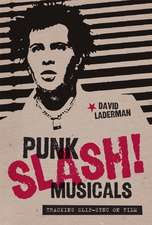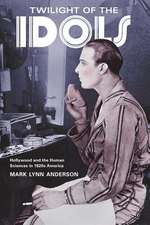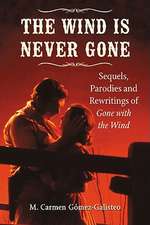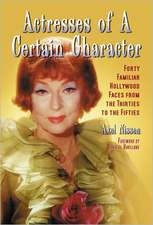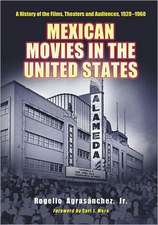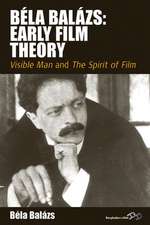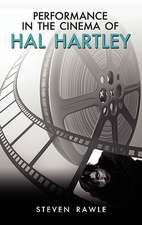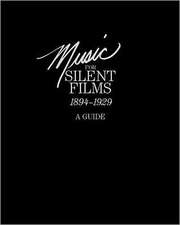Re–viewing Fascism – Italian Cinema, 1922–1943
Autor Jacqueline Reich, Piero Garofaloen Limba Engleză Paperback – 6 mai 2002
Librarul mai recomandă
Preț: 200.17 lei
Nou
Puncte Express: 300
Preț estimativ în valută:
38.30€ • 40.09$ • 31.88£
38.30€ • 40.09$ • 31.88£
Carte tipărită la comandă
Livrare economică 31 martie-14 aprilie
Preluare comenzi: 021 569.72.76
Specificații
ISBN-13: 9780253215185
ISBN-10: 0253215188
Pagini: 384
Ilustrații: 25 b&w photographs
Dimensiuni: 155 x 233 x 24 mm
Greutate: 0.54 kg
Ediția:New.
Editura: MH – Indiana University Press
ISBN-10: 0253215188
Pagini: 384
Ilustrații: 25 b&w photographs
Dimensiuni: 155 x 233 x 24 mm
Greutate: 0.54 kg
Ediția:New.
Editura: MH – Indiana University Press
Cuprins
Contents Acknowledgements Preface Piero Garofalo and Jacqueline Reich Part 1: Framing Fascism and Cinema 1. Mussolini at the Movies: Fascism, Film, and Culture Jacqueline Reich 2. Dubbing L'Arte Muta: Poetic Layerings Around Italian Cinema's Transition to Sound Giorgio Bertellini 3. Intimations of Neorealism in the Fascist Ventennio Ennio Di Nolfo 4. Placing Cinema, Fascism, and the Nation in a Diagram of Italian Modernity James Hay Part 2: Fascism, Cinema, and Sexuality 5. Sex in the Cinema: Regulation and Transgression in Italian Films, 1930-1943 David Forgacs 6. Luchino Visconti's (Homosexual) Ossessione William Van Watson 7. Ways of Looking in Black and White: Female Spectatorship and the Miscege-national Body in Sotto la croce del sud Robin Pickering-Iazzi Part 3: Fascism and Film in (Con)texts 8. Seeing Red: The Soviet Influence on Italian Cinema in the Thirties Piero Garofalo 9. Theatricality and Impersonation: The Politics of Style in the Cinema of the Italian Fascist Era Marcia Landy 10. Shopping for Autarchy: Fascism and Reproductive Fantasy in Mario Camerini's Grandi magazzini Barbara Spackman 11. The Last Film Festival: The Venice Biennale Goes to War Marla Stone 12. Film Stars and Society in Fascist Italy Stephen Gundle Selected Bibliography; Index
Recenzii
"Each essay makes a point of correcting misconceptions about the cinema during the ventennio [the period of fascist rule], which makes this book a significant contribution to the literature."--Choice
Each essay makes a point of correcting misconceptions about the cinema during the ventennio [the period of fascist rule], which makes this book a significant contribution to the literature. --S. Vander Closter, Rhode Island School of Design"Choice" (01/01/2002)
Reich (SUNY, Stony Brook) and Garofalo (Univ. of New Hampshire) have edited a collection of 12 essays treating Italian cinema during the ventennio, the period of fascist rule. Part 1 addresses the cinema's construction of subjectivity (particularly female), linguistic diversity (which challenged the transition from silent to sound cinema), neorealism, and the role of telecommunications and cinema in the formation of nation. The focus shifts in part 2: David Forgacs suggests new ways of identifying the transgressive aspects of regulated and conservative representation of sex in the cinema; others offer a recuperative homosexual reading of Ossessione and an analysis of the colonial discourse of Sotto la croce del sud. Among the essays in part 3 is an examination of the Soviet influence on Italian films of the 1930s; a redefinition of escapist films and their link to contemporary social realities; a reading of Grandi magazzini and the female subject in the context of urban consumerism; a discussion of the 1942 Venice Biennale International Film Festival prize winners and the signs they contain of the deep contradictions and weakness of the fascist regime. Each essay makes a point of correcting misconceptions about the cinema during the ventennio, which makes this book a significant contribution to the literature. Upper--division undergraduates and above.S. Vander Closter, Rhode Island School of Design, 2002dec CHOICE--S. Vander Closter, Rhode Island School of Design, 2002dec CHOICE
Each essay makes a point of correcting misconceptions about the cinema during the ventennio [the period of fascist rule], which makes this book a significant contribution to the literature. --S. Vander Closter, Rhode Island School of Design"Choice" (01/01/2002)
Reich (SUNY, Stony Brook) and Garofalo (Univ. of New Hampshire) have edited a collection of 12 essays treating Italian cinema during the ventennio, the period of fascist rule. Part 1 addresses the cinema's construction of subjectivity (particularly female), linguistic diversity (which challenged the transition from silent to sound cinema), neorealism, and the role of telecommunications and cinema in the formation of nation. The focus shifts in part 2: David Forgacs suggests new ways of identifying the transgressive aspects of regulated and conservative representation of sex in the cinema; others offer a recuperative homosexual reading of Ossessione and an analysis of the colonial discourse of Sotto la croce del sud. Among the essays in part 3 is an examination of the Soviet influence on Italian films of the 1930s; a redefinition of escapist films and their link to contemporary social realities; a reading of Grandi magazzini and the female subject in the context of urban consumerism; a discussion of the 1942 Venice Biennale International Film Festival prize winners and the signs they contain of the deep contradictions and weakness of the fascist regime. Each essay makes a point of correcting misconceptions about the cinema during the ventennio, which makes this book a significant contribution to the literature. Upper--division undergraduates and above.S. Vander Closter, Rhode Island School of Design, 2002dec CHOICE--S. Vander Closter, Rhode Island School of Design, 2002dec CHOICE
Descriere
Examines the feature film production of Fascist-era Italy



